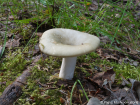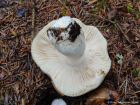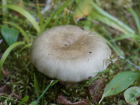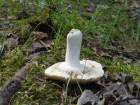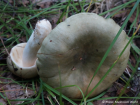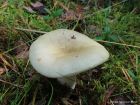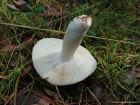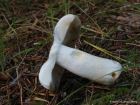Cap convex when young, becoming broadly convex to flat with a shallow depression. It is somewhat sticky and shiny, pale green to light grey-green, more rarely olive green and the skin can easily be peeled off halfway to the centre. The flesh is white, moderately thick, granular and brittle and not changing when sliced. Gills adnexed (attached to the stem at an angle), close together and often fork near the stem. The colour ranges from creamy to pale yellow, sometimes developing brown spots in certain areas. Stem white, sometimes with rust spotting, more or less equal, smooth. The flesh is white, fairly firm but brittle and full. It has no ring. Spore print cream-yellow coloured.
Microscopic Features: Spores are ellipsoidal, measuring 6-10 x 5-7μm (excluding spines). They have rounded warts, about 0.7μm tall, interconnected by a few fine lines, forming a partial network.
Similar species include Amanita phalloides (Death Cap) which has a ring and is not a Russula.
Russula aeruginea on the First Nature Web site. Russula aeruginea on the MushroomExpert.Com Web site.
Many mushrooms are poisonous, and some can be lethally toxic. Distinguishing between edible and poisonous mushrooms can be very challenging. Therefore, we strongly advise against consuming wild mushrooms. This website does not contain any information about the edibility or toxicity of mushrooms.
Although efforts have been made to ensure accuracy on this website, the information may contain errors and omissions. Therefore, all content provided is for educational and informational purposes only and should not be relied upon or used as a basis for consuming any plants or mushrooms.
External links are provided for reference only. We do not endorse or take responsibility for the content, advice, or products found on these sites or in any advertisements shown on this website.
